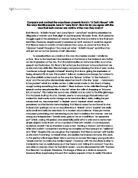Comparatively, Keats depicts the morose nature of unrequited love through the personification of love as a madness or illness. At the start of the letter, Keats explicitly states ‘I have been occupied with nothing but you’ suggesting she is a plague always on his mind; the image is quite invasive implying love has become a physical presence in his body as has ‘loneliness’. Compounding this, Keats states ‘you will call this madness’ suggesting the consequence of unrequited love is an unhealthy obsession. Alternatively, Keats may be hinting that the ‘madness’ is he loves her but there is a reason they cannot be together; writing in the early 1800’s there is the hint that she may be an upper class lady whom he desires but not being part of that class, he cannot marry her. There is sympathy for Keats who is clearly infatuated with a woman who does not reciprocate his love. Consequently, he suffers from a physical illness due to this rejection implied by ‘I am literally worn to death’. The verb ‘worn’ hints that he has been physically beaten down by the effects of love and that love is no longer an abstract feeling but an object beating away at him. Kyd similarly shows love as an illness depicted through ‘harsh and ill’ but rejection has had a different impact on him. While Keats is physically beaten by love, Kyd shows Balthazar to have lost his ability to express beauty in his words; he cannot comprehend writing now she has rejected him. ‘Harsh’ hints at the brutality of rejection and suggests her rejection has physically scarred and hurt him as does ‘ill’ suggesting that as well as being physically attacked, he is mentally hurt by her.
While both writers explore the positivity of love, there are still hints to how vicious it can be. Most noticeably, Kyd uses chivalric language such as ‘valiancy’ and ‘nobler’ implying love is to do with kingship and men being the stronger sex linking to Elizabethan ideas about women being the servants of men, an old biblical idea as Eve was created from Adam’s rib. To also create the idea that love can be positive, Kyd incorporates an iambic rhythm to create a romantic tone; it suggests the soliloquy has carefully being controlled and that he is driven to express his love calmly. This is somewhat contradictory to Balthazar’s earlier hints to love being a madness as well as suggesting that the woman has hindered his ability to write beautiful words. However, the romantic tone may be used to hint that Balthazar – despite being mad with love – is always occupied with love. He does not resent the effect she has had on him but there are definite psychological troubles from this unrequited love. However, Keats uses a continuous prose structure with no paragraphs and short snappy sentences to suggest he is elated with love. He is so pained by it shown by ‘tormented’, he professes his love in a sweep of madness perhaps hinting this is a release to him. From a psychoanalytical perspective, Keats uses this structure to suggest his outpour of emotions is a cure of the repression this love has caused him presenting him as a tragic and sympathetic character.
As well as this, Keats uses religious imagery through ‘I appeal to you by the blood of that Christ you believe him’. ‘That’ suggests dismissiveness of believing in Christ perhaps hinting that Keats has rejected his whole belief system since she has rejected him. He barters with his love saying that she must love him back and believe in his love; perhaps the only issue with their love is the lack of trust between the two people. Symbolically, ‘blood’ could suggest passion and show how metaphorically deep his love him but more likely it hints to sacrifice and therefore is quite sinister in that Keats will sacrifice himself for her love compounded by ‘you can be happy without me’. Perhaps Keats is trying to make a biblical link here suggesting his dedication to this woman is as divine as God’s relationship with Jesus hinted to by the sacrificial image in that Jesus trusted God would make earth peaceful with his sacrifice. Similarly, Keats’s love will evoke peace and divinity.
Overall, Keats and Kyd both depict unrequited love as one that cause’s physical pain and madness show by the personification of love as do the unsteady structures. Indeed, at times the writers are controlled in their writing. Keats at times writes in short snappy sentences but then develops into uses hyphens a number of times to imply confusion but also an unresolved feeling of conflict. He flits between his decisions as if having an internal argument within himself but then resumes his conventional sentence structure. Kyd, however, maintains a steady structure throughout. It could be that the writers are not at the same point of love. Keats is driven mad by love while Kyd’s character, Balthazar, is devoted to this woman but not yet mad with her rejections. However Kyd uses the anaphora of ‘ay, but’ as well as ‘yet, might’ showing also internal conflict and self-debate. She may love him but alternatively she will always look to reason for reasons why this cannot be possible suggesting sympathy for these desperate men. Therefore, overall, unrequited love is depicted as a desperate situation and morose for these writers.








